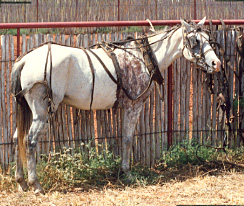 When I snapped the photo of this horse, I didn’t have a chance to talk with its owner, but the rust-colored patch down its shoulder signified to me the flea-bitten gray’s ancestry. “Bloody shoulder” or blood marks are most common in horses of Arabian ancestry, including Thoroughbreds and Quarter Horses with Thoroughbred ancestors.
When I snapped the photo of this horse, I didn’t have a chance to talk with its owner, but the rust-colored patch down its shoulder signified to me the flea-bitten gray’s ancestry. “Bloody shoulder” or blood marks are most common in horses of Arabian ancestry, including Thoroughbreds and Quarter Horses with Thoroughbred ancestors.
Flea-bitten gray refers to a recessive form of gray that causes flecks of the horse’s base color to appear in its coat. All grays become lighter as they age, but flea-bittens develop flecks of color that return to the base color. Bay and chestnut-based grays have red markings and when “flea bites” concentrate in one area, they create a “blood mark.”
Bedouin legend, however, attributes the mark to a courageous Arabian mare who, in spite of being heavy in foal, raced on when her owner was pierced through the heart by pursuing robbers. When she finely reached his tent and the chieftain’s lifeless body was removed from her back, the gray mare bore a broad streak of his dried blood that had run down her shoulder.
That night in the tent of her dead master, the gray mare gave birth to a beautiful gray colt, who had a rusty red mark running down his shoulder. Since that time, according to the legend, every great horse descended from that brave mare and her colt carries the greatly prized mark of the bloody shoulder.
